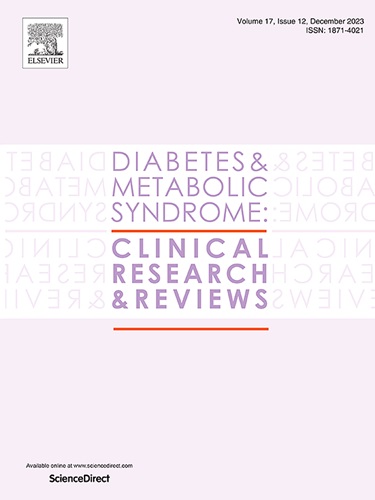Ankle brachial index and brachial-ankle pulse wave velocity as predictor for major adverse limb events and all-cause mortality in diabetes
IF 3.4
Q1 ENDOCRINOLOGY & METABOLISM
Diabetes & Metabolic Syndrome-Clinical Research & Reviews
Pub Date : 2025-05-01
DOI:10.1016/j.dsx.2025.103239
引用次数: 0
Abstract
Background
Ankle-brachial index (ABI) is not a reliable index predicting cardiovascular events, as a significant number of patients with normal ABI do have cardiovascular events. Brachial-ankle pulse wave velocity (BaPWV), a non-invasive vascular assessment index for predicting CV events in normal ABI is not studied in type 2 diabetes (T2D).
Methods
This prospective study included people with T2D from year 2013 until December 2022 or death. Demographics and T2D related complications were recorded. All participants had ABI and BaPWV measured at study entry and grouped based on initial ABI (group A: ABI 0.7–0.9, group B: ABI 0.9–1.2, and group C: ABI >1.2) and sub-categorised based on BaPWV quartiles. The primary objective was to identify BaPWV cut-offs for prediction of all-cause mortality despite normal ABI.
Results
A total of 16000 patients with T2D were screened and 2186 individuals with first incident diabetic foot ulcer (DFU) were evaluated. The median age of participants was 61 (53–67) years, duration of T2D 10 (6–15) years, and follow-up of 6 (2–8) years. Overall, BaPWV>1882 cm/s was associated with reduced survival [HR 0.750 (0.622–0.904); p = 0.003]. Participants with BaPWV >2210 cm/s (HR = 0.48, 95 % CI: 0.33–0.70, p < 0.001) and BaPWV<1642 cm/s (HR = 0.75, 95 % CI: 0.56–1.002, p = 0.051) had higher mortality risk compared to BaPWV 1642–2210 cm/s, despite normal ABI.
Conclusions
A BaPWV>1882 cm/s is associated with reduced survival in people of diabetes. Despite a normal ABI, a BaPWV>2210 cm/s or <1642 cm/s are associated with increased all-cause mortality in people with T2D.
踝肱指数和肱-踝脉搏波速度作为糖尿病患者主要不良肢体事件和全因死亡率的预测因子
踝肱指数(ABI)并不是预测心血管事件的可靠指标,因为大量ABI正常的患者确实存在心血管事件。在2型糖尿病(T2D)中,没有研究用于预测正常ABI中CV事件的非侵入性血管评估指标肱-踝脉波速度(BaPWV)。方法本前瞻性研究纳入2013年至2022年12月期间患有T2D或死亡的患者。记录人口统计学和T2D相关并发症。所有参与者在研究开始时都测量了ABI和BaPWV,并根据初始ABI进行分组(A组:ABI 0.7-0.9, B组:ABI 0.9-1.2, C组:ABI 1.2),并根据BaPWV四分位数进行子分类。主要目的是确定在ABI正常的情况下预测全因死亡率的BaPWV截断值。结果共筛查T2D患者16000例,评估首次发生糖尿病足溃疡(DFU)患者2186例。参与者的中位年龄为61(53-67)岁,T2D持续时间为10(6 - 15)年,随访6(2-8)年。总体而言,bapwv1882 cm/s与生存率降低相关[HR 0.750 (0.622-0.904);p = 0.003]。BaPWV >2210 cm/s (HR = 0.48, 95% CI: 0.33-0.70, p <;0.001)和bapwv1642 cm/s (HR = 0.75, 95% CI: 0.56-1.002, p = 0.051)的死亡风险高于bapwv1642 - 2210 cm/s,尽管ABI正常。结论bapwv1882 cm/s与糖尿病患者生存期降低有关。尽管ABI正常,但bapwv2210 cm/s或1642 cm/s与T2D患者全因死亡率增加有关。
本文章由计算机程序翻译,如有差异,请以英文原文为准。
求助全文
约1分钟内获得全文
求助全文
来源期刊

Diabetes & Metabolic Syndrome-Clinical Research & Reviews
ENDOCRINOLOGY & METABOLISM-
CiteScore
22.90
自引率
2.00%
发文量
248
审稿时长
51 days
期刊介绍:
Diabetes and Metabolic Syndrome: Clinical Research and Reviews is the official journal of DiabetesIndia. It aims to provide a global platform for healthcare professionals, diabetes educators, and other stakeholders to submit their research on diabetes care.
Types of Publications:
Diabetes and Metabolic Syndrome: Clinical Research and Reviews publishes peer-reviewed original articles, reviews, short communications, case reports, letters to the Editor, and expert comments. Reviews and mini-reviews are particularly welcomed for areas within endocrinology undergoing rapid changes.
 求助内容:
求助内容: 应助结果提醒方式:
应助结果提醒方式:


